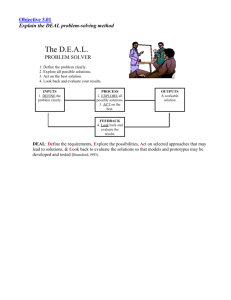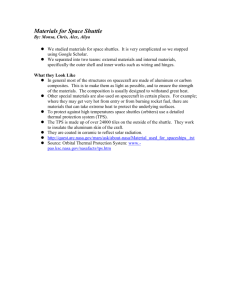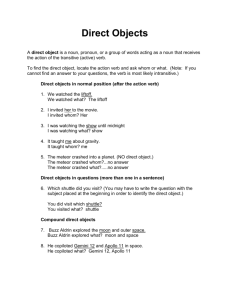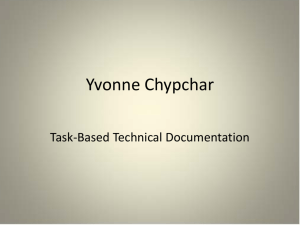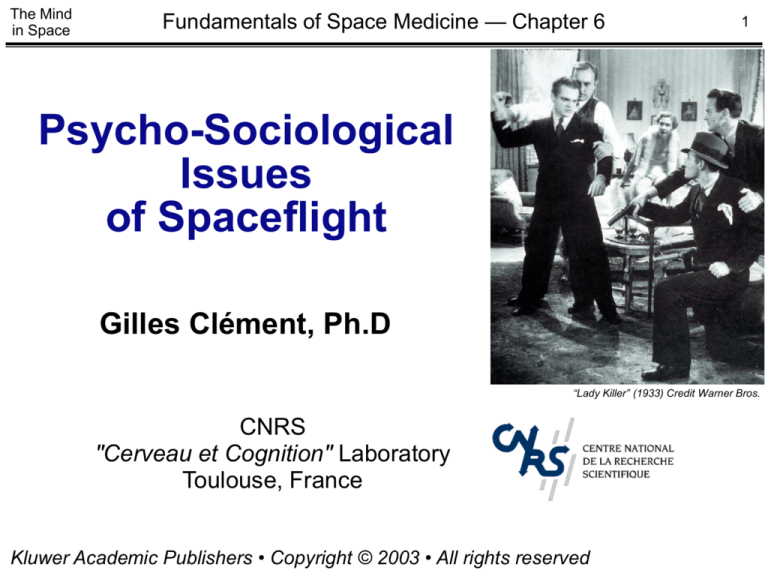
The Mind
in Space
Fundamentals of Space Medicine — Chapter 6
1
Psycho-Sociological
Issues
of Spaceflight
Gilles Clément, Ph.D
“Lady Killer” (1933) Credit Warner Bros.
CNRS
"Cerveau et Cognition" Laboratory
Toulouse, France
Kluwer Academic Publishers • Copyright © 2003 • All rights reserved
The Mind
in Space
Key Concepts
2
• Group/social interaction in isolated, confined environment.
Comparison between spaceflight and analogs (polar bases,
submarines, closed chambers) data
• Individual and crew selection criteria
• Importance of crew psychological training
– Interpersonal communication
– Multicultural sensitivity
– Group dynamic and group problem-solving
• Provision of psychological support
for long-duration space missions
– Pre and In-flight counseling
– Communications
– Postflight debriefing
Apollo-11 quarantine. Document NASA
Movie:
02_quarantine
The Mind
in Space
Human Spaceflight Experience
greater than 30 days
3
The Mind
in Space
Space and Analog Environments
Reported Problems
Mir
Shuttle
Interpersonal conflicts
X
X
Anxiety, depression
X
Sleep disturbances
?
Boredom, restless
4
SubAntarctic
marines stations
?
X
X
X
X
X
?
X
?
Performance decrement
?
X
X
Decline in group
compatibility
?
?
X
Alcohol/substance abuse ?
Adapted from P. Santy (1997) Fundamentals of Space Life Sciences.
Churchill S (ed) Malabar FL: Krieger
X
?
X
X = documented reports
? = anecdotal reports
The Mind
in Space
Adaptation to Isolation
• The lack of external stimulation, monotony, and increasing fatigue
can cause apathy, depression, sleep disorders, psycho-somatic
disorders, decrease in motivation, boredom, and anxiety
• Adaptation generally takes place in 4 phases, independently of
isolation duration :
– 1st quarter: acute adaptation to the
unusual environment (hyper-excitation)
– 2nd quarter: stable adaptation
(with fluctuation of the psychological state)
– 3rd quarter: unstable adaptation
(accompanied by accumulation of fatigue,
narrowing of the interests sphere,
decrease of activity, irritability, aggressivity)
– 4th quarter: “ final effort” period
(euphoria, lack of self-control)
• Following end of isolation: depressional state
5
The Mind
in Space
Communication during an Isolation Study
6
The thickness of the arrows indicates the frequency of communication
A-F: crewmembers
C: commander
Adapted from G. Sandal et al. (1995) Results from ESA’s ISEMSI experiment
The Mind
in Space
Events during 7 NASA-Mir missions
7
• Crew change at L-8 weeks
• Mission extended by 6 weeks
• Minimal control over in-flight
work schedule
•
•
•
•
Work overload / underload
Social withdrawal
Death of family member
Dangerous atmosphere (ethylene
glycol and contaminant leaks)
• Fire; decompression (loss of
module); loss of power (free drift);
communication system failures
• Anger with ground control / management
(“us vs. them” syndrome)
• Crew friction
Mir Station seen from the Space Shuttle. Photo NASA
The Mind
in Space
Characteristics of Effective Crews
8
• Best leaders let crews do work
with minimal interference, but
recognize when group activity is
needed and arrange that activity
• Open communication and
feedback channels
• Clearly defined contingencies
for achieving goals
Movie:
08_recovery2
• Groups of more than 2 have
boundary role persons who
act to interpret interests and
concerns of all sides to allow
activity to progress smoothly
Gemini-11 recovery. Document NASA
The Mind
in Space
Individual Selection Criteria (out)
• “Select-out” criteria are medical criteria specifying those
psychiatric disorders which would be disqualifying:
– e.g., schizophrenia, major depression, etc.
• Psychometric tests (like MMPI) allow to objectively
evaluate if an applicant is a “risk to flying safety”
– questions with answers “yes” or “no”,
such as : “Have you ever been depressed ?”
• Structured psychiatric interview
to counteract the tendency of applicants to minimize
psychological symptoms (“staying clean”)
– questions such as : “Tell me about the time when you
have been most sad in your life”
9
The Mind
in Space
Individual Selection Criteria (in)
• “Select-in” or psychological selection criteria identify
desirable personality traits or characteristics linked to a
specific mission (“best person for the job”):
– Aptitude for job
• Appropriate skills
• Intelligence
• Leadership / Followship
(“team player”)
• Ability to tolerate stress
• Trainability, flexibility
– Motivation
– Sensitivity to self and others
• Emotional stability, maturity
• Ability to form stable quality
interpersonal relationship
White and McDivitt after Gemini 4 4-day
mission. Photo NASA
10
The Mind
in Space
History of NASA Psychologic Evaluation
11
• Mercury
– 30 hours for psychological
evaluation
– 2 psychiatric interviews
– 25 psychometric tests
(IQ, performance,
Rorschach, etc.)
– 5 stress tests (heat, cold,
low barometric pressure,
acceleration, isolation)
– “Select-in” evaluation
based on projected
mission requirements
Scott Carpenter during stress test in heat chamber. Photo NASA
The Mind
in Space
History of NASA Psychologic Evaluation
• Gemini, Apollo, and early Shuttle
– 10 hours for psychological evaluation
– 2 psychiatric interviews
– 10 psychometric tests for Gemini/Apollo; 3 tests for Shuttle
– “Select-in” criteria for Gemini/Apollo; none for Shuttle
Documents NASA
12
The Mind
in Space
History of NASA Psychologic Evaluation
• Shuttle since 1988
– 3 hours for psychological evaluation
– Psychiatric evaluation is part of medical operations
• Psychiatric interview and psychometric testing (MMPI,
MCMI-II, FSSCT) are clinical: only look for pathology
Photo ESA
– Psychological evaluation:
• Research only —
requires voluntary consent
• Goal is to identify those
psychological traits
which predict performance
as an astronaut,
and to validate them
13
The Mind
in Space
Psychometric Testing
14
• Minnesota Multiphasic Personality Inventory (MMPI): consists of
566 items for which a subject is asked to respond true or false
extremely
defensive
outgoing,
spontaneous,
sociable and
confident
present
themselves in
the best
possible light
Adapted From P. Santy (1994)
The Mind
in Space
MMPI Scale
• L — a validity scale; high values indicate evasiveness
(e.g. different responses to about the same questions)
• F — a validity scale; measuring the tendency to present one’s
self on an overly favorable light (low score = more favorable)
• K — a validity scale; measures defensiveness (e.g. underreport,
not completely honest in answering personal questions)
(high score = more defensive)
•
•
•
•
•
Hs — Hysteria
• Pa — Paranoia
D — Depression
• Pt — Psychasthenia
Hy — Hypochondriasis
• Sc — Schizophrenia
Pd — Psychopathic Deviation
• Ma — Mania
Mf — Masculinity/Feminity*
• Si — Social Introversion
* not considered of any significance in defining sexual orientation: high scoring are described as
sensitive, aesthetic, passive; low scoring are described as aggressive, rebellious, and unrealistic
15
The Mind
in Space
MMPI of Japanese
Payload Specialist Applicants
versus U.S. Shuttle Applicants
16
extremely
defensive
outgoing,
spontaneous,
sociable and
confident
present
themselves in
the best
possible light
Adapted From P. Santy (1994)
The Mind
in Space
MMPI of Cosmonauts
17
1—Hypochondria
2—Depression
3—Emotional lability
4—Impulsivity
5—Masculinity/Courage
6—Rigidity
7—Anxiety
8—Nonconformity/Individualism
9—Activity/Optimism
10—Introversion
Adapted From P. Santy (1994)
The Mind
in Space
Astronaut Performance
• Assessment of astronaut performance is required to validate
“select-in” criteria
• Today, performance evaluated on a voluntary basis only :
– Cognitive and psychomotor tests:
• Test of individual tasks to measure vigilance, reaction
time, tracking, coordination, and perceptual speed
– Evaluation from peers:
• Technical skills
(job
performance)
• Ability to live and work with
others (leadership, teamwork,
group living, personality,
communication skills)
• Russian controllers on ground
monitor the number of errors
performed during crew activities
18
The Mind
in Space
Socio-Cultural Factors
STS-51G official crew photo. Photo NASA
19
The Mind
in Space
Isolation / Confinement
• Greater distances are required for personal space :
– in small rooms versus large rooms (White, 1975)
– in rectangular rooms versus square rooms (Worchel, 1986)
– inside locations versus outside locations (Cohran, 1984)
– high anxiety settings versus low anxiety settings (Long, 1984)
– with people whom you
expect to be interacting with
over a long period of time
versus a short interaction
(Worchel, 1986)
Armstrong and Scott
after Gemini 8
emergency landing.
Photo NASA
20
The Mind
in Space
Multi-Gender Issues
21
• Women tend to perceive small, crowded places as friendly and
sociable, while men tend to respond to such environments as
irritating and uncomfortable
• Men are more likely to feel their personal space violated in
crowded places and perceive a continuing challenge to patterns
of male dominance. Thus, men respond to crowded conditions
with greater irritation and hostility than women
• Mixed-gender groups respond to
crowded circumstances nearly as
well as groups of women only
• Studies suggest that the presence
of women exerts a positive influence
(boundary person) and discourages
certain behaviors (e.g., drinking and
fighting) that could lead to injury
or group conflict
Shuttle observatory deck. Photo NASA
The Mind
in Space
Sexuality in Space
22
• There is nothing specifically or formally written
down about sex in space
• All books written on this subject have been
vigorously denied by space agencies
• Russians scientists have studied the impact of
weightlessness on animals’ sex drives in space.
romance and sex for procreation hasn't
figured
prominently in their work
However,
• One published study showed spaceflight causes a reduction in
testosterone levels in male astronauts (Strollo 1998, ASEM)
• “It would be desirable to have a normal sexual life in long-term
spaceflights.” —V. Polyakov
• “People who are professionally very motivated and goal-oriented
do not need sex as an emotional release. A person who might
experience such problem in flight will most likely be a passenger
on a spacecraft -- a journalist, a politician or just a tourist.”
The Mind
in Space
Multi-Cultural Issues
23
• Interpersonal distances:
– Latin American, French and Arab interact at closer distances
than U.S., English, Swedish, or German individuals
– Use of eye contact not only varies by gender, but also by
social and cultural norms
– Facial expression is a way to communicate: swollen face in
0-g creates problem
• Issues of personal
hygiene and
housekeeping alone
account for about 40% of
incidents during space
missions with unicultural
(i.e., U.S. only) crews
Dinner in the Skylab kitchen. Photo NASA
The Mind
in Space
Microgravity Issues
24
• Hygiene routines are time
consuming and laborious
(no gravity!)
• Food does not taste the same and
spices must be added for flavor
• Countermeasures may require
effortful and time-consuming activity
• Motivation to do the required
countermeasures becomes
increasingly hard
• Physiological adaptations to
microgravity challenge and stress
individuals, and impact interpersonal
interaction, concentration, ability to
perform group and individual work
Exercising on board Skylab. Photo NASA
The Mind
in Space
Crew Selection Issues
25
• Crew size
– Potential for conflict increases with crew size
– Odd / Even number of crewmembers
– All-male, all-female, or mixed-gender groups
Movie:
– Command structure (autocratic or democratic)
25_piloting
• Differences in education / culture
– Age
– Values
Pilots train for Shuttle landing.
Document NASA
– Compatibility
• e.g., scientists: tend to not interact, and not to work
well in a hierarchical command structure; prefer autonomy
• pilots-astronauts: have military backgrounds, which lead them
to prefer a more ordered command structure
• Occupational role
– Cross-trained individuals
• Leadership should belong to the individual whose style
stimulates the group process and maintains group performance
and morale
The Mind
in Space
Psychological Training
26
• Soviet/Russian space program uses extensive pre- and in-flight
psycho-social support activities and psychological monitoring
– Survival training
– Parachute training
– Provide constant reminders
of Earth via music, video, books
– Personal items in re-supply ships
– Surprises and holidays
– Frequent contact with family,
friends, artists, media
– Voice analysis by ground
psychologists to detect stress
and interpersonal conflicts
Survival training in Russia. Photo NASA
The Mind
in Space
ISS Preflight Psy Support
27
• NASA Psychological Services Group started in 1994 (NASA-Mir)
• Support begins when ISS crewmembers deploy for training in Star
City: advocate for improved conditions and resources; assist with
family contacts; off-hours recreation
• Involvement in issues that could
later affect in-flight psy support :
– Work and rest schedule
– Habitability (acoustic, crew quarters)
– Food variety
– Language training; culture training
• Family involvement in preparation :
Dinner on board Mir. Photo NASA
– Informal meetings with immediate family;
interest / hobby questionnaire completed for crewmember;
personal preference kits for crewmember
– Family Support Office
The Mind
in Space
ISS In-flight Psy Support
• Monitoring individuals and team
– Flight surgeon primary link with crews during flight
– Private conferences with crewmembers, as needed
– Cognitive assessment (WinSCAT) developed
– Behavioral and Fatigue assessment tools being considered
• Support activities
– Personal items re-supply via Progress
and Shuttle
– Transmitting news and event information
– Private family conferences
– Amateur radio communication
– E-mail, personal cell phones
• Family Support Office
– Regular contact maintained with family
– Information about mission (especially contingencies)
28
The Mind
in Space
ISS Postflight Psy Support
• Postflight meetings with crewmember
and family
– Assess overall psychological health
– Assess practical value of current psy
preparation and support
– Follow-up on specific mission events
regarding individual, crew and family
reactions and adaptation
– Obtain recommendations for improving
support for following crews
• Support as needed to return as soon as
possible to regular work and family life
“Humming to myself, I float through the [Salyut] station. [...]
Is it possible that some day I’ll be back on Earth
among my loved ones, and everything will be all right?”
__Valentin Lebedev (after 116 days in orbit)
29
The Mind
in Space
Additional Reading
30
• Burrough B (1998) Dragonfly. New York, NY: Harper Collins
• Clément G (2003) Fundamentals of Space Medicine. Dordrecht:
•
•
•
•
•
•
•
Kluwer Academic Publishers
Harrison AA, Clearwater YA, McKay CP (eds) (1991) From Antarctica
to Outer Space: Life in Isolation and Confinement. New York, NY:
Springer-Verlag
Kanas N (1991) Psychosocial support for cosmonauts. Aviat Space
Environ Med 62: 353-355
Lebedev V (1988) Diary of a Cosmonaut: 211 Days in Space. College
Station, TX: Phytoresource Research Inc, Information Service
Linenger JM (2000) Off the Planet. New York, NY: McGraw-Hill
Sandal GM, Vaernes R, Ursin H (1995) Interpersonal relations during
simulated space missions. Aviat Space Environ Med 66: 617-624
Santy PA (1994) Choosing the Right Stuff. The Psychological
Selection of Astronauts and Cosmonauts. Wesport, CO: Praeger
Stuster JC (1996) Bold Endeavors: Lessons from Polar and Space
Exploration. Annapolis, MD: Naval Institute Press


